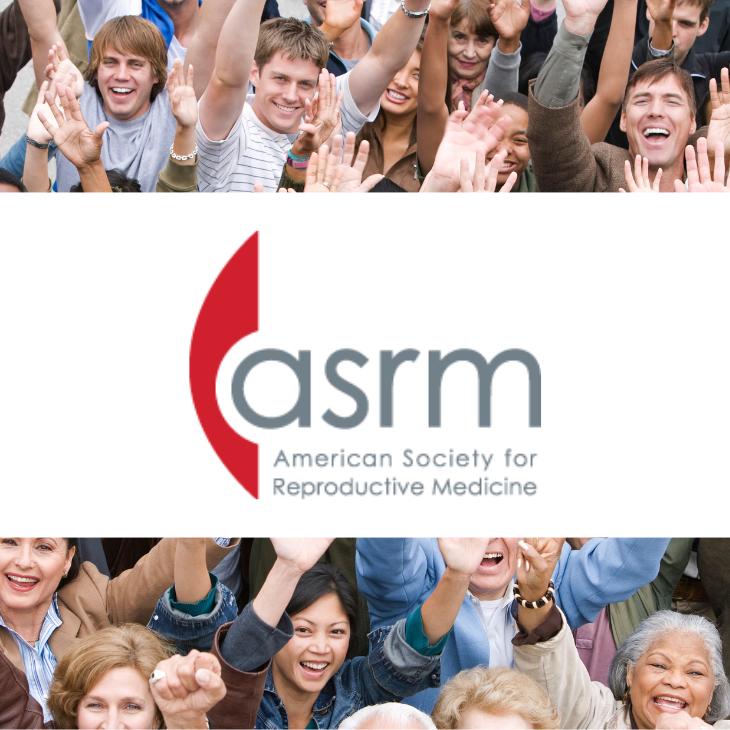The History of ASRM
History
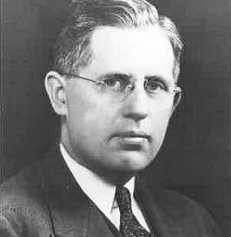 The American Society for Reproductive Medicine (ASRM) was founded in 1944 by a small group of fertility experts, led by Walter Williams, M.D., who met in Chicago. Thirty men were elected as founding members, as well as a six-member Board of Directors. The Board, in turn, chose Dr. Williams as President. Initially, the Society was known as the American Society for the Study of Sterility, [2] whose “preamble and purposes” were stated succinctly in the Society’s constitution:
The American Society for Reproductive Medicine (ASRM) was founded in 1944 by a small group of fertility experts, led by Walter Williams, M.D., who met in Chicago. Thirty men were elected as founding members, as well as a six-member Board of Directors. The Board, in turn, chose Dr. Williams as President. Initially, the Society was known as the American Society for the Study of Sterility, [2] whose “preamble and purposes” were stated succinctly in the Society’s constitution:In consideration of the apparent existence of a need for more scientific and efficient handling of the infertility problem, including well-directed research, the improvement of methods of diagnosis and treatment, and the dissemination of reliable information concerning fertility and infertility, it is here proposed to constitute an organization of those eminently qualified to further the above tenets.[3]
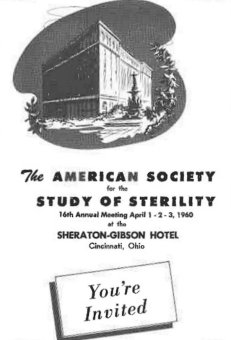 During the next two decades, the Society saw a significant surge in membership; established its position as the imminent Society of its kind in the United States; set standards for how it would interact with the press; and considered ways to grow its annual meeting, having held its first one in 1947, including the addition of postgraduate courses. The search for a clearer identity cropped up in 1957 and a suggestion to change the Society’s name to the American Fertility Society was made. Opponents persisted until 1965, when the name change became official. [4]
During the next two decades, the Society saw a significant surge in membership; established its position as the imminent Society of its kind in the United States; set standards for how it would interact with the press; and considered ways to grow its annual meeting, having held its first one in 1947, including the addition of postgraduate courses. The search for a clearer identity cropped up in 1957 and a suggestion to change the Society’s name to the American Fertility Society was made. Opponents persisted until 1965, when the name change became official. [4]Also, 1965 marked the beginning of a five-year period during which membership grew yet even more. With that, the Society began publishing its first newsletter. Additionally, the size of the Society journal, Fertility and Sterility, increased. [5]
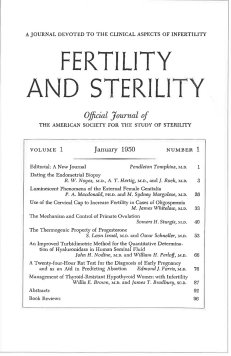 “The ultimate and real success of the Society is going to be essentially dependent upon the quality of its scientific productivity and the proper dissemination of the scientific productivity of its individual members,” Dr. Walter Williams said in 1950. A decade later, that productivity had grown markedly. The Society had become a notable breeding ground for scientific advance. This showed in the addition of pages to Fertility and Sterility to accommodate a burgeoning of contributions and in the fact that this added space took only a small bite out of the backlog of quality papers reported by the editor. It showed the achievements of such members as John Rock, in the move toward Society-sponsored postgraduate training, in the quality of the annual scientific program, and in other Society initiatives. [6]
“The ultimate and real success of the Society is going to be essentially dependent upon the quality of its scientific productivity and the proper dissemination of the scientific productivity of its individual members,” Dr. Walter Williams said in 1950. A decade later, that productivity had grown markedly. The Society had become a notable breeding ground for scientific advance. This showed in the addition of pages to Fertility and Sterility to accommodate a burgeoning of contributions and in the fact that this added space took only a small bite out of the backlog of quality papers reported by the editor. It showed the achievements of such members as John Rock, in the move toward Society-sponsored postgraduate training, in the quality of the annual scientific program, and in other Society initiatives. [6]In 1964, the 20th Annual Meeting drew 663 people to Bal Harbor, MA to celebrate passage of the first full generation in the Society’s life. The Society has grown from 30 members to 1,951 members. Society president, Dr. David Danforth, as he looked back on the state of the science in the mid-1940s said, “At that time our main preoccupation was with occluded tubes, failure of ovulation, the influence of anatomic variations, the effect of thyroid extract or stimulating doses of x-ray to the ovary, and the like, as they are concerned in fertility and sterility.” Shifting to the present he said, “How similar in some ways to the subjects we still debate, except that we have achieved an increasing awareness that the field of our particular interest runs the whole gamut of physiology. In addition, our interests have now extended from the simple management and evaluation of infertility to its artificial inducement.” [7]
In 1965, the members voted to change the name of the Society to The American Fertility Society. The long debate on the issue pitted those who favored tradition and believed that an organization’s actions, not its name, mattered, against those who thought the name cumbersome, unwieldy and misleading. Also, in 1965, the Society issued its first newsletter, reporting the Society’s name change and the results of the 21st Annual Meeting. [8]
Recognizing that government was exerting increasing influence over medicine, including its own specialty, in 1977-78, the Society moved to make its views known in policymaking circles. Its first action was to sign an agreement with the American College of Obstetricians and Gynecologists to share that organization’s Washington, D.C. office. This office was intended to keep membership informed on legislative matters of importance to reproductive medicine and provide a means to make the Society’s voice heard by the appropriate individuals and government agencies on matters of concern to the Society. [9]
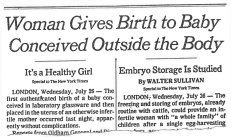 On July 25, 1978, the world received the news that a five-pound, 12-ounce baby fertilized in a petri dish in a laboratory had been born in England. She was Louise Brown, the daughter of a Bristol truck driver and his wife. Two courageous and persistent scientists, who had helped make this birth possible, gynecologist, Patrick Steptoe and physiologist, Robert Edwards, shared the joy of the parents. For the first time in world history, a new method of human conception had succeeded. As a result, reproductive medicine would never be the same. [10]
On July 25, 1978, the world received the news that a five-pound, 12-ounce baby fertilized in a petri dish in a laboratory had been born in England. She was Louise Brown, the daughter of a Bristol truck driver and his wife. Two courageous and persistent scientists, who had helped make this birth possible, gynecologist, Patrick Steptoe and physiologist, Robert Edwards, shared the joy of the parents. For the first time in world history, a new method of human conception had succeeded. As a result, reproductive medicine would never be the same. [10]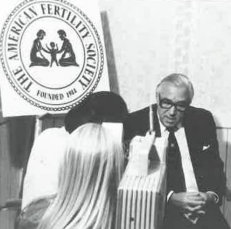 Since many members of the Society knew the British doctors and were intimately familiar with this work, the achievement also had a personal dimension. Many Society members felt a shared pride in the achievement. In addition to what it contributed to science and medicine, the birth brought modern reproductive techniques into the public spotlight as never before. For members of the Society, the achievement was crowned by the appearance of Dr. Steptoe at the opening of the 35th Annual Meeting in San Francisco on February 5, 1979. His topic: “Extra Corporeal Conception in the Human.” By all accounts, this was one of the most moving and dramatic moments in the Society’s history—an occasion remembered well by the 1,200 or so persons who were there. [11]
Since many members of the Society knew the British doctors and were intimately familiar with this work, the achievement also had a personal dimension. Many Society members felt a shared pride in the achievement. In addition to what it contributed to science and medicine, the birth brought modern reproductive techniques into the public spotlight as never before. For members of the Society, the achievement was crowned by the appearance of Dr. Steptoe at the opening of the 35th Annual Meeting in San Francisco on February 5, 1979. His topic: “Extra Corporeal Conception in the Human.” By all accounts, this was one of the most moving and dramatic moments in the Society’s history—an occasion remembered well by the 1,200 or so persons who were there. [11] As 1981 drew to a close, an effort that had begun on the day Louise Brown was born came to a successful and happy conclusion when the first baby conceived by invitro fertilization was born in America, in Norfolk, Virginia. The birth was a triumph for Drs. Howard and Georgeanna Jones, and others at the Eastern Virginia Medical School. At the same time, the event was hailed within the Society as a family affair, for the Joneses and others involved were active members. After the birth, Dr. Howard told the press, “I think this day is a day of hope” for the approximately 600,000 American women unable to have children because of tubal defects. [12] IVF remained the center of attention within the Society and the profession in 1982. [13]
As 1981 drew to a close, an effort that had begun on the day Louise Brown was born came to a successful and happy conclusion when the first baby conceived by invitro fertilization was born in America, in Norfolk, Virginia. The birth was a triumph for Drs. Howard and Georgeanna Jones, and others at the Eastern Virginia Medical School. At the same time, the event was hailed within the Society as a family affair, for the Joneses and others involved were active members. After the birth, Dr. Howard told the press, “I think this day is a day of hope” for the approximately 600,000 American women unable to have children because of tubal defects. [12] IVF remained the center of attention within the Society and the profession in 1982. [13]From almost the time of its founding, women have taken an active part in the activities of the Society, and in the early 1980s a number of members formed the Women’s Council to increase the role women would play both within the Society and in the fertility profession. The Society’s first woman member is believed to have been Helen Gladys Kain, M.D., who joined in 1946. Other women followed, and in following years the number of women members continued to rise, never dramatically, but always steadily. [14]
Specialists within the Society began to organize in 1984 around their areas of interest and to form subsections of the organization. The first to formalize the new arrangement were the reproductive endocrinologists, followed in short order by the reproductive surgeons and IVF specialists. The aims of the groups—and others that followed—were to generally provide a forum in which their special interests could be aired and to develop special training, research and other useful programs and projects. [15]
As IVF continued to develop, producing new reproductive possibilities never before considered, the Board of Directors of the Society charged its Ethics Committee to conduct a thorough study of these advances and report its conclusions. The result was the start of a process of ethical examination that continues to this day, and that, in its depth and duration, is probably without precedent in American medicine. [16]
As the 1980s progressed, it was clear that the Society had, in recent years, grown not only in number of members, but also in its breadth of interest. As the boundaries of fertility research kept expanding, they blended into other subject areas, and fertility specialists followed with them. As a result, subjects and problems traditionally thought not to be of interest to members began moving into the Society’s programs. The fertility organization was, in fact, becoming more and more a society of experts in reproductive medicine and biology. One such subject was ectopic pregnancy, which turned up in the 1987 program. Other “new” topics were menopause and contraception. Taken together, these activities indicated that, although an organization dedicated to a specialty, the Society was becoming more inclusive than ever. [17]
As early as 1982, nurses working in reproductive endocrinology and infertility had begun to network and communicate informally at the Society’s annual meetings, and a blueprint for an official nurses’ group was born. The group was officially recognized within the Society as the Special Interest Group for Nurses in Reproductive Medicine in 1988, at the Atlanta annual meeting. By 1990, the nurses SIG had a membership of 380, published a newsletter, accepted abstracts, and held a clinically oriented symposium. [18]
At about the same time the nurses’ group became an official part of the Society, the formation of a Psychological Special Interest Group was officially recognized at the 1988 annual meeting. Members had a preview of a patient education brochure, “If You Are Having Trouble Conceiving…” that was written by a PSIG committee and published by the Society. [19]
A full awareness of the growing importance of the federal government’s involvement in reproductive medicine prompted the Society to open an office in Washington, D.C. in 1989 and to launch an active program of federal and state affairs. That same year, the Society held a symposium in Washington to educate policy-makers on progesterone. The need for a Washington presence was demonstrated quickly, for that March, a panel of Society members testified at a Congressional hearing on IVF/GIFT clinics. The hearing was held by the House Subcommittee on Regulation and Small Business Opportunities headed by Rep. Ron Wyden of Oregon. A major focus was a survey of 139 IVF/GIFT clinics coordinated by Wyden with the cooperation of AFS and SART. Rep. Wyden gave the AFS and SART high marks for their work on the survey. He termed the project “a model for cooperative efforts between government and the private sector,” and called on the medical community to standardize the method of calculating success rates, develop advertising guidelines, and set professional standards for IVF/GIFT clinics. [20]
As the Society entered the last decade of the 20th Century, major steps were taken to ensure the Society’s organizational viability well into the next century. Four major developments occurred: appointment of a full-time medical director, establishment of a fund to make possible the purchase of a building to serve as Society headquarters, expansion of the Washington office, and the establishment of a Practice Committee to develop guidelines for reproductive health-care providers. [21]
The Society entered the 1990s as if caught up in a whirlwind. Its activities expanded dramatically in response to government’s growing involvement in reproductive medicine, growth in scientific and clinical activity, and growth in the requirements necessary to serve its members. This new pace carried with it an acknowledgement that the Society had evolved to the point where even its name no longer reflected the full reality of its nature. [22]
Members came to a full realization that the scope of the Society had broadened to include not only investigation and treatment of infertile couples, but all aspects of reproductive endocrinology, including contraception, menopause, and the endocrine problems of puberty. [23] As members prepared to attend the 50th anniversary meeting of the Society in San Francisco in 1994, a major item on the business agenda was a proposed name change which ultimately passed member vote as the American Society for Reproductive Medicine. [24]
In another major action announced to members, the Board of Directors had approved the purchase of a new 14,600 square-foot Society headquarters building, located in a Birmingham, AL suburb. The Society moved into this building –its administrative headquarters--in January 1993. [25]
 As part of the celebration of the Society’s 50th anniversary, members were invited to comment on its history. Dr. Melvin Taymor of Brookline, MA, points to a paradox he believes was a catalyst to recent advances. “It itself,” he says “IVF has not been a single breakthrough. The knowledge and techniques that made IVF possible had been accumulating over the previous 30 years.” Instead, he views the efforts of the 1960s and 1970s to control the population explosion as “the engine that drove the growth in the field.” While this may seem paradoxical, he says contraception “brought an increased number of basic scientists and clinical researchers into the discipline of reproductive medicine.
As part of the celebration of the Society’s 50th anniversary, members were invited to comment on its history. Dr. Melvin Taymor of Brookline, MA, points to a paradox he believes was a catalyst to recent advances. “It itself,” he says “IVF has not been a single breakthrough. The knowledge and techniques that made IVF possible had been accumulating over the previous 30 years.” Instead, he views the efforts of the 1960s and 1970s to control the population explosion as “the engine that drove the growth in the field.” While this may seem paradoxical, he says contraception “brought an increased number of basic scientists and clinical researchers into the discipline of reproductive medicine.“The subspecialty board of reproductive endocrinology was established, and each year brings additional, research-minded physicians into the field. As a result, there was a marked expansion. First in knowledge, then in new techniques: the availability of ovulation-inducing drugs, the radioimmunoassay, which unlocked the secrets of pituitary-ovarian relationships, studies on oocyte maturation, the laparoscope, and ultrasound—all of which made IVF and other therapies possible. And with all this came the progressive growth of our society.” [26]
Steven Klein, M.D., of Lyndhurst, Ohio, expressed the view that “the major breakthrough in the field in the last 50 years is to make the public aware of fertility and to give women hope when there used to be none.” [27]
Dr. Pendleton Tompkins, the last living founding member of the Society, died on June 27, 1994 at his home in San Mateo, CA. He was 87. Just days before his death, Dr. Tompkins was video-taped reminiscing about his decades with the Society. That interview, conducted as part of the Society’s Golden Anniversary activities, was to be a highlight of the videotape program shown to members at the 50th Annual Meeting. With Dr Tompkins’ passing, an era died, but there was no doubt that exciting new times lay ahead for the Society in the future. [28]
ASRM’s Continued Activities and Achievements
75th Anniversary - In 2019, ASRM noted its 75th anniversary with celebratory events held at its annual Scientific Congress & Expo, including a well-attended gala, which raised funds for the Society’s new Research Institute. [29]Relocation of ASRM Headquarters - Also at its 2019 Scientific Congress & Expo, the Society announced the relocation of its headquarters to Washington, D.C. The Society continues to maintain an administrative/operations office in Birmingham, AL. [30]
Research Institute - In 2018, the Society created the ASRM Research Institute, focusing on areas that will have the most impact on the practice of reproductive medicine, particularly when other funding sources are inadequate. Funding from the institute allows current researchers and the next generation of researchers to explore relevant topics, such as basic human gametes and embryos, the human trophectoderm, the role of precision medicine in reproductive care, and access to care. [31]
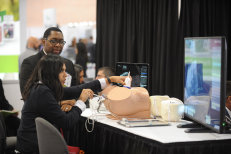 Embryo Transfer Simulation Program - Created in 2016 as part of ASRM’s 2014 – 2019 strategic plan, the embryo transfer simulation program provides training via virtual reality embryo transfer simulators. The training is offered predominantly to fellows. Since early 2016, trainees in the U.S. and around the world have performed ultrasound-guided embryo transfer via simulation, using a variety of uterine/cervical scenarios of varying difficulty. A number of upgrades have been made as experience with the simulation has accumulated. The embryo transfer simulation training program has grown in popularity and success with its continued refinement. [32]
Embryo Transfer Simulation Program - Created in 2016 as part of ASRM’s 2014 – 2019 strategic plan, the embryo transfer simulation program provides training via virtual reality embryo transfer simulators. The training is offered predominantly to fellows. Since early 2016, trainees in the U.S. and around the world have performed ultrasound-guided embryo transfer via simulation, using a variety of uterine/cervical scenarios of varying difficulty. A number of upgrades have been made as experience with the simulation has accumulated. The embryo transfer simulation training program has grown in popularity and success with its continued refinement. [32]NGO Status - In 2014, ASRM was voted an official Nongovernmental Organization (NGO) of the World Health Organization (WHO), by the WHO Board of Directors. ASRM continues to maintain that status and is committed to working with colleagues, governments, and other NGOs around the world, as we strive to improve global reproductive health. [33]
Advocacy – ASRM maintains an advocacy function at its headquarters in Washington, D.C., advocating and lobbying federal and state governments on behalf of professionals practicing within the field of reproductive medicine and their patients. Efforts are focused on access to care and financial relief related to assisted reproductive technology (ART) care. In recent years, ASRM has partnered with RESOLVE: The National Infertility Association, in bringing both professionals and patients to Capitol Hill on Advocacy Day to meet with Members of Congress to advocate on behalf of infertility patients and the physicians and other allied health-care professionals who care for them. [34]
Access to Care - As compared to other countries, public payers in the U.S., for the most part, do not cover infertility services and, while a few state mandates for some coverage are in place, most private plans are exempted, leaving the majority of patients to pay out of pocket for their infertility care. ASRM has formed an Access to Care Committee and an Access to Care Special Interest Group to address the issues of infertility patients in the U.S., as well as infertility patients around the word who have difficulty accessing infertility care due to geography, demographics, and other issues. [35]
Timeline of Advances in the Field of Reproductive Medicine
1953 – First successful pregnancy using frozen sperm [36]1960 – First use of HMG for ovulation induction [37]
1960 – The first oral contraceptive, Enovid, was approved by the U.S. Food and Drug Administration (FDA) as contraception. [38]
1965 – The Supreme Court, in Griswold v. Connecticut, gave married couples the right to use birth control, ruling that it was protected in the Constitution as a right to privacy. [39]
1967 – Clomiphene citrate approved by the FDA [40]
1971 – First microsurgical vasectomy reversal performed by Earl Owen [41]
1973 – Roe v. Wade, 410 U.S. 113, a landmark decision issued by the U.S. Supreme Court, addresses the constitutionality of laws criminalizing or restricting access to abortions. [42]
1975 – First human pregnancy achieved using electroejaculation. [43]
1977 – First successful invitro fertilization (IVF) pregnancy achieved (although no birth resulted). [44]
1978 – First baby born from IVF, Louise Brown, in England. [45]
1981 – First human pregnancy achieved using penile vibratory stimulation. [46]
1981 – First IVF baby born in the United States, Elizabeth Jordan Carr. [47]
1983 – First successful egg donation [48]
1984 – First report of ultrasound-guided transvaginal oocyte retrieval [49]
1984 – First baby born from a frozen embryo [50]
1985 – First successful gestational surrogacy completed [51]
1990 – Fist child born following pre-implantation genetic diagnosis (PGD) [52]
1992 – First successful pregnancy using intra-cytoplasmic sperm injection (ICSI) [53]
1993 – First successful pregnancies using testicular sperm extraction (TESE) followed by ICSI [54]
1994 – First succsessful pregnancies using microsurgical epididymal sperm aspiration (MESA) followed by ICSI [55]
1997 – First report of IVF births after TESE and ICSI for men with NOA from Klinefelter syndrome [56]
1999 – Natalie Brown, younger sister of Louise Brown, becomes the first IVF baby to naturally give birth to a child. [57]
2014 – Birth of a baby to a woman receiving a uterine transplant from a living 61-year-old donor [58]
2015 – Zika virus emerges as a threat to unborn babies. ASRM along with the CDC, FDA, and WHO, releases guidelines for providers caring for zika virus exposed and infected individuals planning pregnancy. [59]
2017–2018 – The reproductive health community focuses on access to care. [60]
ASRM Journals
 The Society’s “official” journal, Fertility and Sterility, began publication in January 1950 with the lead article, Dating the Endometrial Biopsy, written by Drs. R.W. Noyes, A.T Hertig and J. Rock. It’s founding editor was Pendleton Tompkins, M.D. Within two years, the journal had more than 2,000 subscribers, comparing favorably to journals of societies with much larger memberships and longer histories. [61] Fertility and Sterility remains the official journal of ASRM, but has been joined by additional journals, including the Journal of Assisted Reproduction and Genetics, F&S Reviews, F&S Reports, and F&S Science. [62]
The Society’s “official” journal, Fertility and Sterility, began publication in January 1950 with the lead article, Dating the Endometrial Biopsy, written by Drs. R.W. Noyes, A.T Hertig and J. Rock. It’s founding editor was Pendleton Tompkins, M.D. Within two years, the journal had more than 2,000 subscribers, comparing favorably to journals of societies with much larger memberships and longer histories. [61] Fertility and Sterility remains the official journal of ASRM, but has been joined by additional journals, including the Journal of Assisted Reproduction and Genetics, F&S Reviews, F&S Reports, and F&S Science. [62]Additional Publications
ASRM maintains Practice, Ethics and Patient Education committees that consistently review, update and publish new relevant materials to the field of reproductive medicine offering guidelines for ethical and appropriate practice in the field, as well as patient education materials. These can be found on www.ASRM.org and www.ReproductiveFacts.org. [63]ASRM Member Groups
Affiliates - ASRM Affiliated Societies are made up of professionals who have special training and expertise in specific areas of reproductive medicine. These include the Society for Assisted Reproductive Technology, Society for Male Reproduction and Urology, Society of Reproductive Biologists & Technologists, Society for Reproductive Endocrinology & Infertility, and Society of Reproductive Surgeons.
Professional Groups - ASRM Professional Groups allow members to network and collaborate with other professionals who have an interest in the field of reproductive medicine. ASRM Professional Groups include the Advanced Practice Providers, Association of Reproductive Managers, Genetic Counseling, Legal, Mental Health, and Nurses’ professional groups.
Special Interest Groups - ASRM Special Interest Groups provide programming and leadership to physicians and health professionals who have a special interest in a particular area of reproductive medicine. These include the Access to Care, Androgen Excess, Chinese, Complementary & Integrative Medicine, Complex Family Planning, Early Pregnancy, Endometriosis, Environment and Reproduction, Fertility Preservation, Fibroid, Health Disparities, Imaging in Reproductive Medicine, LGBTQ, Menopause and Ovarian Insufficiency, Nutrition, Pediatric and Adolescent Gynecology, Physician-Scientists’, Preimplantation Genetic Testing, Regenerative Medicine and Stem Cell Biology, Reproductive Immunology, Turkish, and Women's Council special interest groups. [64]
Websites
- www.ASRM.org - ASRM’s member and public website
- www.ReproductiveFacts.org – ASRM’s patient education website
- www.ASRMCongress.org – ASRM’s website dedicated to information about its annual Scientific Congress and Expo
References
[1] ASRM Mission Statement. https://www.asrm.org/about-us/mission-statement/.
[2] Duka, M.S., Walter E., & DeCherney, M.D., Alan H. (1995) From the Beginning, A History of the American Fertility Society 1944-1994. Birmingham, AL: ASRM. pgs 1-2.
[3] Duka and DeCherney, pg 21.
[4] Duka and DeCherney, pg 99.
[5] Duka and DeCherney, pg 100.
[6] Duka and DeCherney, pg 85.
[7] Duka and DeCherney, pgs 95-96.
[8] Duka and DeCherney, pg 100.
[9] Duka and DeCherney, pgs 146-148.
[10] Duka and DeCherney, pgs 151-152.
[11] Duka and DeCherney, pg 154.
[12] Duka and DeCherney, pgs 163, 166.
[13] Duka and DeCherney, pg 169.
[14] Duka and DeCherney, pg 174.
[15] Duka and DeCherney, pg 179.
[16] Duka and DeCherney, pg 187.
[17] Duka and DeCherney, pg 196.
[18] Duka and DeCherney, pgs 201, 203.
[19] Duka and DeCherney, pg 204.
[20] Duka and DeCherney, pgs 205-206.
[21] Duka and DeCherney, pgs 215, 217.
[22] Duka and DeCherney, pg 222.
[23] Duka and DeCherney, pg 222.
[24] Duka and DeCherney, pg 222.
[25] Duka and DeCherney, 223.
[26] Duka and DeCherney, pg 230.
[27] Duka and DeCherney, pg 236.
[28] Duka and DeCherney, pg 250.
[29] ASRM 2019 Scientific Congress and Expo
[30] ASRM Press Release: Medical Society to Move Headquarters Out of Alabama.
[31] ASRM Research Institute. https://www.asrmresearch.org/
[32] ASRM 2014-2019 Strategic Plan.
[33] ASRM Achieves NGO Status with the WHO.
[34] ASRM Office of Media and Public Affairs.
[35] ASRM Access to Care Special Interest Group.
[36] Kramer, W. (2017). A Brief History of Donor Conception. Retrieved from https://www.huffpost.com/entry/a-brief-history-of-donor-conception_b_9814184
[37] Beall, SA & DeCherney, A. The History and Challenges Surrounding Ovarian Stimulation in the Treatment of Infertility. Fertil Steril. 2012 Apr; 97(4): 795–801. https://www.ncbi.nlm.nih.gov/pmc/articles/PMC4199635/
[38] Planned Parenthood Federation of America. (2015). The Birth Control Pill: A History. Retrieved from https://www.plannedparenthood.org/files/1514/3518/7100/Pill_History_FactSheet.pdf
[39] Griswold v. Connecticut. (n.d.). Oyez. Retrieved February 14, 2020, from https://www.oyez.org/cases/1964/496
[40] Adashi, EY. (2017). Clomiphene citrate at 50: the dawning of assisted reproduction. Fertil Steril, 2017 Oct; 108(4): 592-593. https://www.fertstert.org/article/S0015-0282(17)31697-7/fulltext
[41] Earl Owen. In Wikipedia. Retrieved February 14, 2020, from https://en.wikipedia.org/wiki/Earl_Owen
[42] Roe v. Wade. In Wikipedia. Retrieved February 14, 2020, from https://en.wikipedia.org/wiki/Roe_v._Wade
[43] Sonksen J, et al. Pregnancy after assisted ejaculation procedures in men with spinal cord injury. Arch Phys Med Rehabil. 1997 Oct;78(10):1059-61. https://www.ncbi.nlm.nih.gov/pubmed/9339152
[44] History of in vitro fertilisation. In Wikipedia. Retrieved February 14, 2020, from https://en.wikipedia.org/wiki/History_of_in_vitro_fertilisation
[45] Fertility Solutions Blog. The First Successful IVF Birth. Retrieved February 14, 2020, from https://fertilitysolutions.com.au/the-first-successful-ivf-birth/
[46] Meng, X, et al. Electroejaculation combined with assisted reproductive technology in psychogenic anejaculation patients refractory to penile vibratory stimulation. Transl Androl Urol. 2018 Mar; 7(Suppl 1): S17–S22. https://www.ncbi.nlm.nih.gov/pmc/articles/PMC5881218/
[47] Elizabeth Jordan Carr. In Wikipedia. Retrieved February 14, 2020, from https://en.wikipedia.org/wiki/Elizabeth_Jordan_Carr
[48] Kramer, W. (2017). A Brief History of Donor Conception. Retrieved from https://www.huffpost.com/entry/a-brief-history-of-donor-conception_b_9814184
[49] Seifer, DB, et al. Follicular aspiration: a comparison of an ultrasonic
endovaginal transducer with fixed needle guide
and other retrieval methods. Fertil Steril, 1988 Mar; 49(3): 462-467. https://www.fertstert.org/article/S0015-0282(16)59774-X/pdf
[50] AP. First Baby Born of Frozen Embryo. (1984). Retrieved from https://www.nytimes.com/1984/04/11/us/first-baby-born-of-frozen-embryo.html
[51] Surrogacy. In Wikipedia. Retrieved February 14, 2020, from https://en.wikipedia.org/wiki/Surrogacy
[52] Silva, P. (2014). First Baby Born Healthy After Pre-Implantation Genetic Diagnosis for CF in Ireland. Retrieved from https://cysticfibrosisnewstoday.com/2014/07/08/first-baby-born-healthy-pre-implantation-genetic-diagnosis-cf-ireland/
[53] UCSF Health FAQ: Intracytoplasmic Sperm Injection/ Retrieved from https://www.ucsfhealth.org/education/faq-intracytoplasmic-sperm-injection
[54] Yu, Y, et al. Pregnancy and Neonatal Outcomes in Azoospermic Men After Intracytoplasmic Sperm Injection Using Testicular Sperm and Donor Sperm. Med Sci Monit. 2018; 24: 6968–6974. https://www.ncbi.nlm.nih.gov/pmc/articles/PMC6178868/
[55] Sperling, H. et al. [MESA (microsurgical epididymal sperm aspiration) and IVF (in vitro fertilization). A therapy concept in treatment of male infertility]. Urologe A. 1995 Sep;34(5):409-12. https://www.ncbi.nlm.nih.gov/pubmed/7483159
[56] Kavoussi, P.K., Odenwald, K.C., Summers-Colquitt, R.B. et al. Live birth following donor oocyte IVF/ICSI with surplus cryopreserved MicroTESE retrieved sperm: a case report. J Assist Reprod Genet 32, 485–486 (2015). https://doi.org/10.1007/s10815-014-0421-y
[57] BioNews. (1999). First baby for mum born of IVF. Retrieved from https://www.bionews.org.uk/page_87917
[58] Uterus Transplantation. In Wikipedia. Retrieved February 14, 2020, from https://en.wikipedia.org/wiki/Uterus_transplantation
[59] ASRM Practice Committee Guidance for Providers Caring for Women and Men Of Reproductive Age with Possible Zika Virus Exposure (Modified from CDC, FDA, and WHO Published Guidance) https://www.asrm.org/globalassets/asrm/asrm-content/news-and-publications/practice-guidelines/for-members/guidance_for_providers_zika_virus_exposure.pdf
[60] WHO. Universal access to reproductive health. https://www.who.int/gho/maternal_health/reproductive_health/en/
[61] Duka and DeCherney, pgs 6, 35-38.
[62] Fertility and Sterility.
[63] ASRM Publications.
[64] ASRM Member Groups.
Learn More About ASRM
Find out more about the American Society for Reproductive Medicine
Mission, Vision and Values
The American Society for Reproductive Medicine (ASRM) is dedicated to the advancement of the science and practice of reproductive medicine.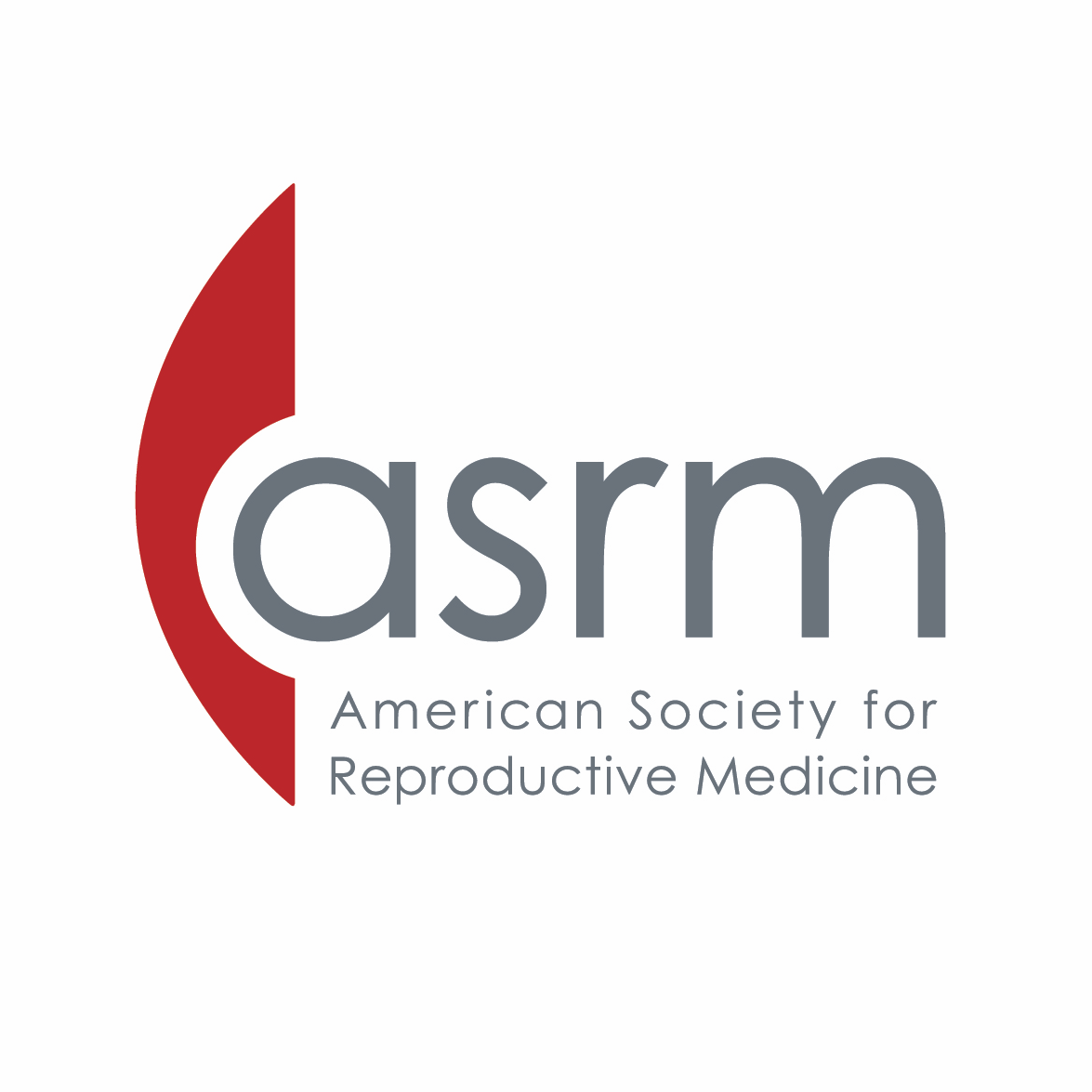
Strategic Plan & Initiatives
ASRM has established several strategic goals and initiatives to advance the science and practice of reproductive medicine through education, research, advocacy, and public awareness.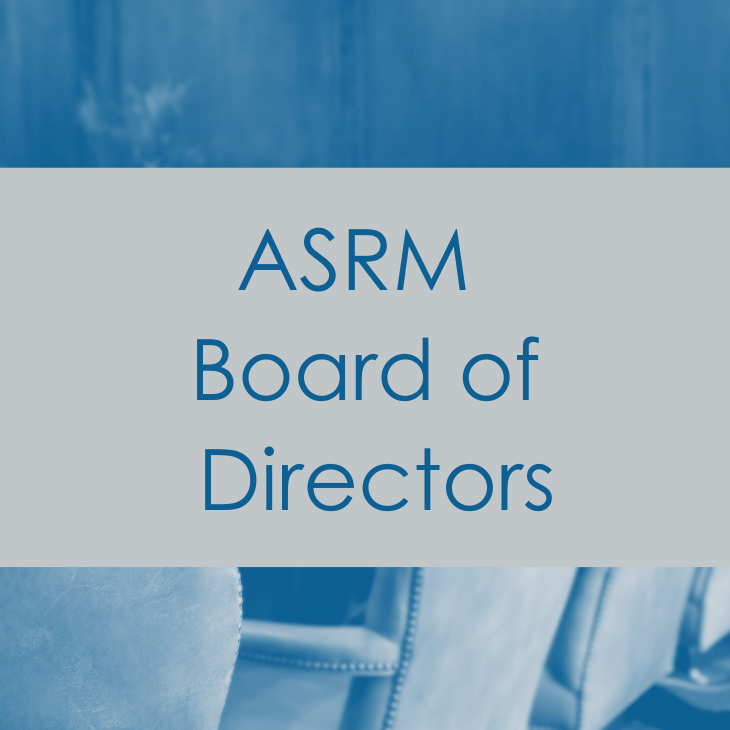
Board of Directors
The ASRM Board of Directors is committed to advancing the reproductive medicine field and providing patients with high-quality care. The Board works tirelessly to ensure that the organization is meeting the needs of its members and the public.